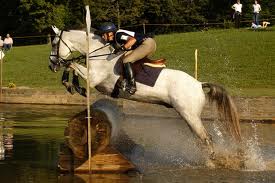|
~Cross country~Cross country requires both horse and rider to be in excellent physical shape and to be brave and trusting of each other. Consisting of approximately 12–20 fences (lower levels), or 30–40 at the higher levels, placed on a long outdoor circuit. These fences consist of very solidly built natural objects (telephone poles, stone walls, etc.) as well as various obstacles such as water, ditches, drops and banks, and combinations including several jumping efforts based on objects that would commonly occur in the countryside.

Sometimes, particularly at higher levels, fences are designed that would not normally occur in nature. However, these are still designed to be as solid as more natural obstacles. Safety regulations mean that some obstacles are now being built with a "frangible pin system," allowing part or all of the jump to collapse if hit with enough impact. Speed is also a factor, with the rider required to cross the finish line within a certain time frame (optimum time). Crossing the finish line after the optimum time results in penalties for each second over. At lower levels, there is also a speed fault time, incurring penalties for horse and rider pairs completing the course too quickly. For every "disobedience"(refusal or run-out of a jump) a horse and rider incur on course, penalities will be added to their dressage score. After 3 disobediences the pair is eliminated, meaning they can no longer participate in the competition.
A horse and rider pair can also be eliminated for going off course, for example missing a fence. Should the horses shoulder or hind-quarter touch the ground, mandatory requirement is taken and they are not allowed to participate further in the competiton. If the rider should fall off the horse they are eliminated. However in the US this rule is currently being revised for the Training level and below. The penalties for disobediences on cross country are weighted severely relative to the other phases of competition to emphasize the importance of courage, endurance and athleticism. Fitness is required as the time allowed will require a strong canter at the lower levels, all the way to a strong gallop at the higher events.
Horse trials, which may be held over one or two days, have only one phase of cross country. If the trial is held over the course of two days, dressage and show jumping are usually held the first day, with cross country on the second. In recent years, a controversy has developed between supporters of short and long format three-day events. Traditionally, three day events had dressage, endurance and show jumping. Endurance day consisted of 4 phases, A, B, C and D. Phase A and C were roads and tracks, with A being a medium-paced warm up to prepare the horse and rider for Phase B, a steeplechase format at an extremely fast pace over steeplechase-style fences. Phase C was a slow-paced cool down coming off of Phase B, in preparation for the toughest and most demanding phase, D, or cross-country. Before embarking on Phase D, in the "ten-minute box," horses had to be approved to continue by a vet, who monitored their temperature and heart rate, ensuring that the horse was sound and fit.
Three day events are now offered in the classic format, with endurance day, or short-format, with no steeplechase (phase B) or roads and tracks (phases A and C). The 2004 Olympic Summer Games in Athens, Greece chose the short format, due to lack of facilities, time and financing, which sparked a large debate in the eventing community whether to keep the steeplechase phase or just offer cross-country. Today, most events are run short-format, except for a few one-star competitions.
Due to major injuries at Red Hills and Rolex in 2008, the rules were changed drastically. The change stated that a fall anywhere during the cross-country phase resulted in elimination, even if the rider was galloping on course and not approaching a jump, or in the middle of a combination. Also, a new rule created elimination for riding in jumping phases without a medical arm band carrying information about the rider's medical history, insurance, medications, and blood type.
Scoring
~Refusal, run-out, or circle at an obstacle: 20 penalties
~Second refusal, run-out, circle at the same obstacle: 40 penalties
~Third refusal, run-out, circle on cross-country course: Elimination
~Fall of rider: Elimination
~Fall of horse (shoulder and hind touch the ground): Elimination
~Exceeding Optimum Time: 0.4 penalties per second
~Coming in under Speed Fault Time: 1 penalties per second (lower national levels in some countries only)
~Exceeding the Time Limit (twice the optimum time): Elimination
Return to Horse Riding Connection
|
